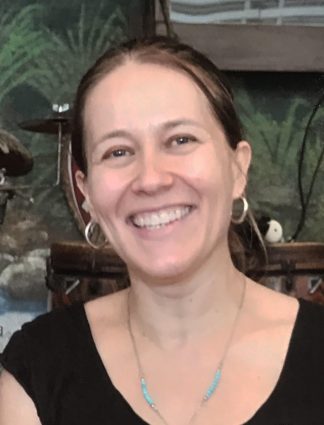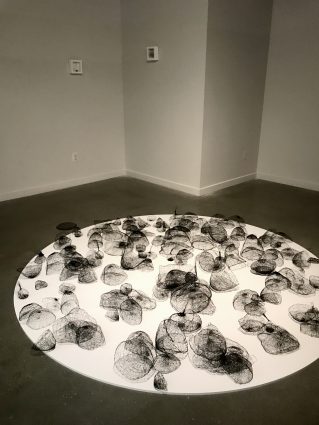Irene Pantelis attributes her deep love of nature to her South American heritage. Born in La Paz, Bolivia, she grew up there as well as in Brazil and Uruguay. Her Methodist missionary parents “relocated to new posts every few years.” The Chevy Chase-based artist, who also spent ages 2 to 5 in New York City, has lived in the Washington metropolitan area since age 16.
The Andes Mountains and summers spent at her grandparents Colonia, Uruguay farm not only anchored her amid the frequent moves and consequential feelings of displacement, but also fostered an awareness “of the richness and diversity there is in this world.”
Thus, it is only natural that nature is key to Pantelis’ “Beneath My Lawn,” an installation of small three-dimensional drawings made with polylactic acid filament (PLA), on view through Jan. 6 in the Common Ground Gallery at VisArts in Rockville.
In her “process-based” art practice, Pantelis typically begins “with a word or notion and finds materials that I think relate to it. I then experiment and let the materials ‘tell’ me the form of the art piece,” she said. “It is a bit like Michelangelo’s notion that inside a marble block lives a statue waiting to be uncovered by an artist.”

For “Beneath my Lawn,” she said, that initial notion was “that the grass around the house where I live is like a cover, like a surface, under which lie hidden hundreds of stories and histories.” From there, she proceeded “to imagine that these narratives all intertwine and connect to things past and things far away in ways I will never fully know or understand.”
As Pantelis “played” with a 3D-pen and “experimented with the possibilities of the PLA filaments,” she “came upon these small forms that I created by wrapping the filament around my knees, hands and piles of fabric. The forms turned out like webs or nets that reference a lot of different things — roots, dust balls, archeological artifacts, human hair and breasts, among other things.”
“When light hits the shapes in the right way,” she noted, “they cast a shadow that doubles their volume and appears to enter into the ground.”
The artist hopes that viewers of the installation “will project their own associations with lawns and roots and webs” as a result of her effort “to find the connections between daily life and what I perceive as a bigger grid out there, one that extends across geographical boundaries and across time.”
Pantelis connects her proclivity to spread across boundaries to the “many cultures in my personal life, thanks to my parents and my marriage.” Her husband is part Brazilian and part Indian. “This richness gives me so much to mine as a creator not just conceptually but visually,” she said. “More importantly, having so many cultures as a single person kind of frees you from all of them and opens you up to a more universal worldview and identity.
“I think that my hyper mixed heritage is why my art is about the big picture, like a meditation on the entire history of humankind, illustrated through natural forms,” she concluded.
Pantelis said she was “always artistically inclined … sketching and collaging as a child and building small objects from materials my parents collected for me.” Her parents, she noted, “exposed me always to museums and literature (and) ingrained in me an appreciation for folk art and traditions.”
Still, art took a back seat for many years. After graduating from Montgomery Blair High School in Silver Spring, she majored in Spanish language and literature University of Maryland-College Park. From there, the self-described “highly creative and idealistic” twentysomething, went to Georgetown Law School thinking I could change the world.” She practiced “employee-side” labor law for a decade “first at a law firm, and then at a federal-sector labor organization,” then chose to stay home with her young children for five years.

Throughout her 20s and 30s, Pantelis said, “art was my passion on the side.” Weekly figure drawing sessions at Micheline Klagsbrun’s studio and classes at the Corcoran School of Art helped her “keep a certain focus on the bigger picture of things – as well as deal with the stress of practicing law.” As for her law practice affecting art, she said, “I am not sure, but it certainly enabled me to travel a lot and see art around the world.”
When she became a stay-at-home parent, Pantelis’ art and her attitude toward it changed. “It went from representational to abstracted and expressive,” she said. “As the years went on, it became clear to me that art was really my passion and that I wanted to devote all my attention to it.” Thus, she returned to the University of Maryland for a second bachelor’s degree, this time in studio art, in 2016, and anticipates complete a master of fine arts in 2019.
For the next few months, Pantelis will be putting together her thesis show, which will be on view in April and May at the University’s Art Gallery in College Park. Once that “huge undertaking” is completed, she aspires to “continuing to make work, to show locally, and hopefully nationally and internationally as well.”
Irene Pantelis’ “Beneath my Lawn” is on view through Jan. 6 in the Common Ground Gallery at VisArts, 155 Gibbs St., second floor, Rockville Town Square. Hours are noon to 4 p.m. Wednesday, Thursday, Saturday and Sunday, and noon to 8 p.m. Friday. The galleries are closed on Christmas and New Year’s Day. Call 301-351-8200 or visit www.visartscenter.org.